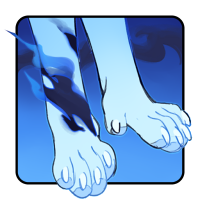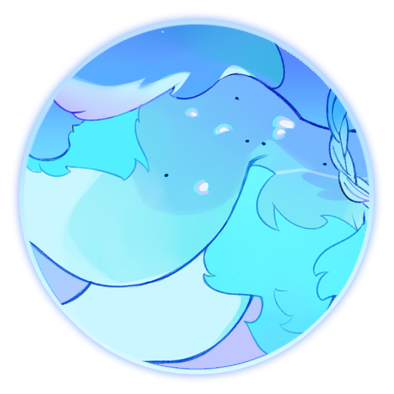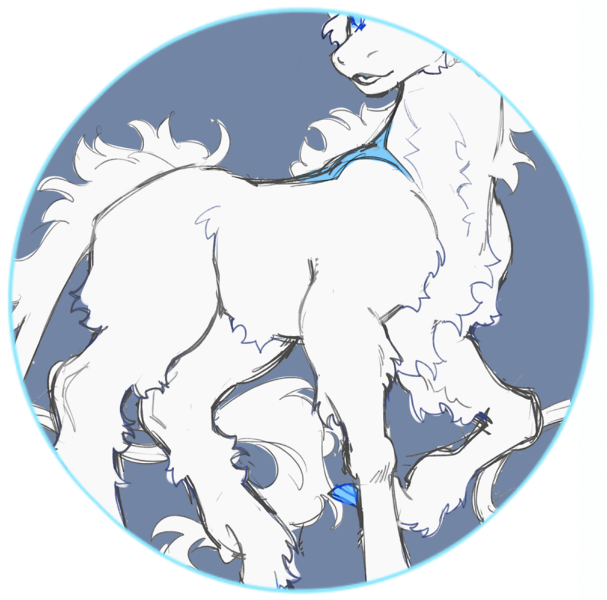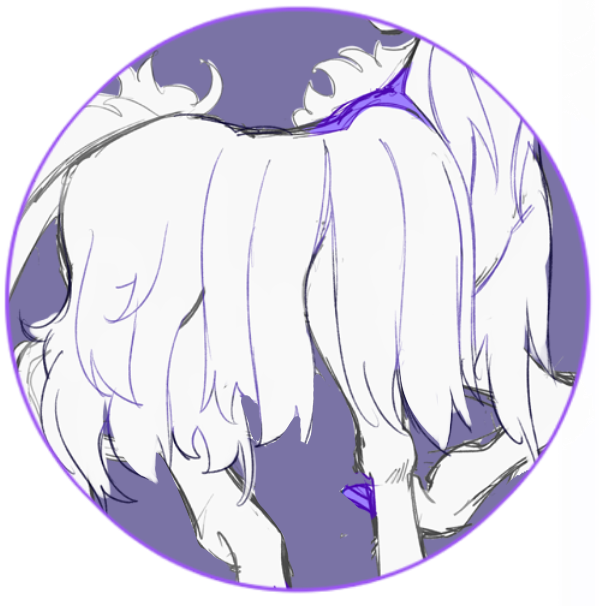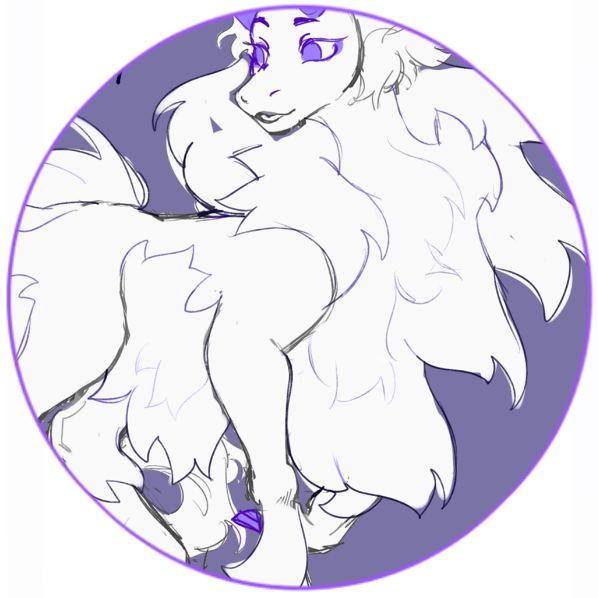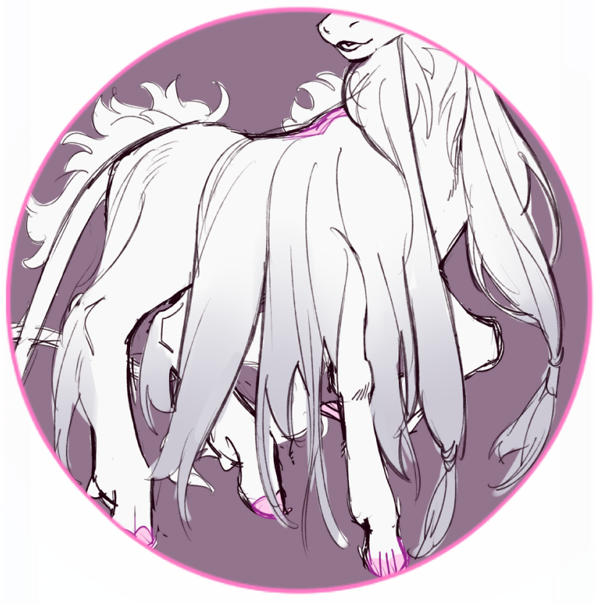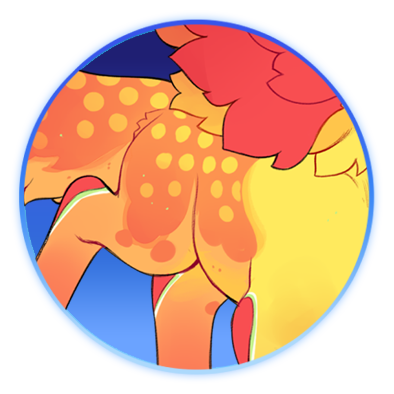Traits
A Touch of Wickedness (★ Seasonal)
Evidence of having come across something wicked. A small, dark, and cloudy mark clings to your bab. It almost looks like it's alive with the way it's edges seem to blur and crisp.
-
A Touch of Wickedness
Allows you to apply a single dark wisping mark onto one part of your bab.
🔹This mark should look cloudy, or as though a small burn mark has started to appear on the bab, a dark bit of smoke can emanate from it.
🔹This mark can change shape at times, and it's edges seem to shift often, though the placement stays the same.
🔹 A bab with this mark may experience fatigue or ache where the mark rests, exacerbated by physical or magical exertion.
❗ The mark must be kept small and mostly connected, with a few flickers or specks surrounding.
❗ The mark should stay featureless, with no patterning or speckling directly on the mark.
❗ Smoke emanating from the mark can be dark, or saturated with a darker base as it touches the mark.


-
On Hair:
🔹 A mantibab whose hair has been affected may display this trait as multiple dark points or a thick, single lock that bleeds into the natural hair color.

-
On Eyes:
🔹 See: A Gaze of Wickedness
Pastel Coat (Blessed)
Note: The Pastel Coat is not currently obtainable outside of sales and auctions.
- This trait is Incomplete and is not currently accurate.
![]() Pastel Mantibabs are the lightest any Mantibab earned through the ARPG can be.
Pastel Mantibabs are the lightest any Mantibab earned through the ARPG can be.
It is always a celebration when a Mantibab is born with fair fur that covers its entire body. Pastel coated babs are thought to be given to souls that are destined for greatness, or who have a grand purpose. The lighter the coat, the purer the soul, and the grander task set before them. Welcomed with open arms and often given special treatment by the most superstitious of babs. Pale coated Mantibabs are susceptible to illness moreso than others, and there is said to be an illness only they can catch, but most tend to brush that off.
Here are some examples of existing Pastel Mantibabs
![]() Pastel Mantibabs can be completely pastel within the range shown! 40% of their coat may be white or off-white hues (cream, white, ivory). Pastels that are very nearly white or present too light are included in this percentage. (visuals to be added!)
Pastel Mantibabs can be completely pastel within the range shown! 40% of their coat may be white or off-white hues (cream, white, ivory). Pastels that are very nearly white or present too light are included in this percentage. (visuals to be added!)
Which colors fall into pastel?
🔹 These hues are all safe to use over the entire coat!
Which pastels are considered too light?
🔹 Pastel hues that present too close to white are limited alongside the use of proper white/off-white colors. The range below would not be allowed to compose the majority of your Crederian.
VIsual examples
🔹 These examples will be the general guidelines for how the pastel amounts will be graded. Accents (horns, cheeks, ankle/elbow nubs, paws, and eyes) do not count towards the coat color limitations.
Did you know? Hair counts towards the color limitations and may skew your percentage if it is too long. Consider hair as another limb when calculating your white amounts.
![]() Any Mantibab that is completely pastel on the official masterlist that does not fall under any of the staff or admin accounts will be considered a Pastel Mantibab, even if they do not follow the limitations to the letter. These Mantibabs are grandfathered in and cannot be replicated under this trait. Completely pale or white mantibabs are only available to NPC Deities and their descendants, and is not able to be obtained as a trait.
Any Mantibab that is completely pastel on the official masterlist that does not fall under any of the staff or admin accounts will be considered a Pastel Mantibab, even if they do not follow the limitations to the letter. These Mantibabs are grandfathered in and cannot be replicated under this trait. Completely pale or white mantibabs are only available to NPC Deities and their descendants, and is not able to be obtained as a trait.
Pastel Halfling (Enchanted)
Note: The pastel Halfling Coat is not obtainable through an Enchanted Trait Amulet
- This trait is Incomplete and is not currently accurate.
![]() Mantibabs are highly superstitious! Pastel Halflings are considered "lucky charms" by their peers, often treated well and finding themselves making friends fast.
Mantibabs are highly superstitious! Pastel Halflings are considered "lucky charms" by their peers, often treated well and finding themselves making friends fast.
A Mantibab will rarely (from birth, through magical means, an encounter with a benevolent being, or by sheer luck) find their coats lightening, usually in patches or fading gradients that eat away at their naturally vivid hues. This transformation never reaches the full coat, with the bab retaining some of their natural vivid hues, leaving them stuck halfway into vivid and pastel territory. They are often praised and looked after to see if their coats will fully lighten into the sought after pastel hues, which can be a blessing or a curse depending on the Mantibab on the recieving end...
Here are some examples of existing Pastel Halfling Mantibabs
![]() Halfling Pastel Mantibabs should have 30% - 40% of their coat retain vivid hues while the rest can be a combination of pastels and white. Within the remaining ~60%, half of this percentage may be white or off-white hues (cream, white, ivory). Pastels that are very nearly white or present too light are included in this half. (visuals to be added!)
Halfling Pastel Mantibabs should have 30% - 40% of their coat retain vivid hues while the rest can be a combination of pastels and white. Within the remaining ~60%, half of this percentage may be white or off-white hues (cream, white, ivory). Pastels that are very nearly white or present too light are included in this half. (visuals to be added!)
Which colors fall into pastel?
🔹 These hues are all safe to use up to the entire ~60% of your Mantibabs coat if you do not use any white/off-white hues.
Which pastels are considered too light?
🔹 Pastel hues that present too close to white are limited alongside the use of proper white/off-white colors. The range below would not be allowed to compose the majority of your Crederian.
VIsual examples
🔹 These examples will be the general guidelines for how the pastel amounts will be graded. Accents (horns, cheeks, ankle/elbow nubs, paws, and eyes) do not count towards the coat color limitations.
Did you know? Hair counts towards the color limitations and may skew your percentage if it is too long. Consider hair as another limb when calculating your color amounts.
![]() Any Mantibab that is heavily pastel, but retains any significantly vivid hue will be considered a "halfling", even if they do not follow the limitations to the letter. These Mantibabs are grandfathered in and cannot be replicated under this trait.
Any Mantibab that is heavily pastel, but retains any significantly vivid hue will be considered a "halfling", even if they do not follow the limitations to the letter. These Mantibabs are grandfathered in and cannot be replicated under this trait.
Umbra Halfling (★ Mythical)
Your bab has gained a partial dark coat through some unfortunate means.
Upwards of 50% of your Mantibab may have a dark coat.
Umbra Coat (Cursed)
A wretched encounter has left your Mantibab on the brink of death. They made it, but at what cost? Their coat is permanently marred by death, and will reflect in the newly gained dark strands. This item grants your Mantibab a fully dark pelt, with some grains of hues retained in either markings or other light features.
Accents must retain their hue.
Standard Coat (★ Common)
Kanti fur is capable of being velvety or dense and ranges from soft to coarse depending on environment and how much care they put into themselves. A standard length of fur varies depending on the body part, but generally the thickest places fur lies is along the back (mane), around the neck (ruff), and on the rump. The legs can gain a "draft" quality to them but should not be excessively long or resemble unicorn fetlocks!

Draped Coat (★ Uncommon)
A mid length coat whose fur more resembles hair that drapes down towards the knees. This coat can be styled to resemble a cape or cloak, with fur able to grow like pants along the rump. This coat can be pinned and styled and should be straight or wavy in texture.
Flared Coat (★ Uncommon)
A mid length coat whose fluff billows out in impressive displays. Fur that grows upwards and outwards in unusual fashion. Dense "boots" of fur growing upwards are a popular styling choice.
Husky Coat (★ Uncommon)
Also known as the "Tundra Coat". The husky coat is a dense and warm set of fluff that hangs heavy and usually grows thickest along the neck, underbelly, and haunches. Stylish boots can adorn the legs as protection from the cold.
Curly Coat (★ Rare)
A peculiar coat type that curls in all manner of directions. Seen as a bit of an attractive anomaly, Kanti can't seem to attain the curly coat without luck or magic intervention.
Wooly Coat (★ Rare)
A dense and coiled fur type resembling that of wool. This fur may be donated to create clothing for others. Sometimes a donee may be the one creating themselves!
Trailing Coat (★ Rare)
A long and flowing coat that resembles hair more than fur. This coat tends to reach the floor, and may drag along it if left unkempt. These coats are often braided or pinned fashionably.
Vivid Coat (★ Common)
![]() This is a core aspect of mantibabs and is mandatory for all standard forms of this species. They contain heavily saturated hues and have restrictions on pastel and light hues. Please read the rules carefully to ensure this is the species for you.
This is a core aspect of mantibabs and is mandatory for all standard forms of this species. They contain heavily saturated hues and have restrictions on pastel and light hues. Please read the rules carefully to ensure this is the species for you.
All standard mantibabs are covered in a coat of vivid color. Vibrant hues of lightly differing values dance along their fur and shine in the sun, sharing the vibrancy of the magic that permeates Crederia itself. Their colorful coats define their species as a whole, with dull, dark, pale, or pastel coats being extremely rare and having deep significance in their lore.
Here are some examples of existing mantibabs with vivid coats
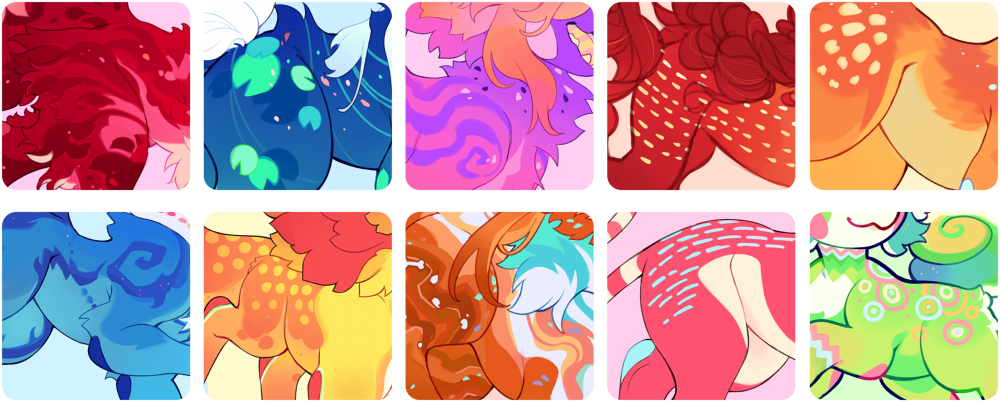
![]() Vivid coats must be 60% vivid hues, which gives a 40% allowance of combined saturated pastel/white hues. A vivid mantibab will never have grey, muddy, or dark colors.
Vivid coats must be 60% vivid hues, which gives a 40% allowance of combined saturated pastel/white hues. A vivid mantibab will never have grey, muddy, or dark colors.
Which colors fall into vivid?
🔹 These hues are all safe to use and can be used to fill your entire coat! Mix and match between them with no issue.
TBA
🔹 These hues should be used sparingly, and will not be accepted as a Mantibab's base coat color, but will be acceptible as markings and gradients.
TBA
What about pastels?
🔹 Pastel hues are classified within this visual range, and are able to be used in combination with whites up to 40% of your Mantibab before encroaching into rarer territory.
How much is too much?
🔹 Vivid Mantibabs should always lean towards the colorful side, with pastels, whites, and creams used to enhance a design rather than overtake it. Making use of cutouts, underbellies, blanket markings, masks, and the like are all welcome as long as we stick to the 40% rule. Does your bab look half pastel half vivid? You will be asked to reduce some of the lighter colors.
![]() Looking for other coat traits? Mantibabs will be able to upgrade their coats with hard-to-get items, getting rarer the further down the list you go: Pastel Halfling, Umbra Halfling, Pastel Coat, and Umbra Coat. Each of these coat types have in-game significance and will affect your Mantibab in different ways.
Looking for other coat traits? Mantibabs will be able to upgrade their coats with hard-to-get items, getting rarer the further down the list you go: Pastel Halfling, Umbra Halfling, Pastel Coat, and Umbra Coat. Each of these coat types have in-game significance and will affect your Mantibab in different ways.
